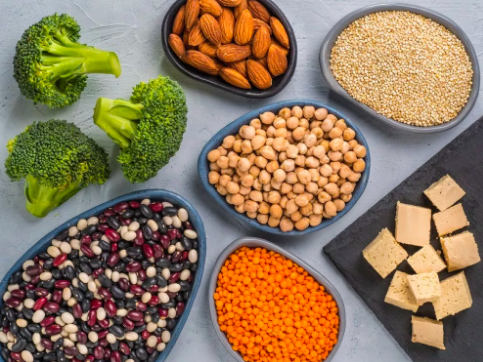Why We Need to Eat Complete Proteins – Important Advice for Vegetarians and Vegans
Katie Noble, BNatMed.
SPCNM Graduate Practitioner 2019
Protein is a big deal for the body. We need it to make hair, tendons, ligaments, muscles, nails, and cells including genes. Plus it is required for enzymes and hormones. Creating all of these protein products is like following a recipe where different combinations of 20 amino acids create 30,000 – 50,000 unique proteins. Individual amino acids can make some hormones and neurotransmitters like serotonin – our feel-good hormone, adrenaline, noradrenaline, thyroid hormone and nucleic acids in our DNA.
Every day we revert around 400 gm of our bodies back to individual amino acids which are used to reform protein structures allowing us to grow, heal, remodel and defend ourselves constantly. We can create some of the amino acids ourselves, but there are 9 that are considered essential as they have to be sourced from our diet.
The 9 essential amino acids, their functions & food sources
Histadine (infants)
Needed for histamine production which is vital to immune response, digestion, sexual function and sleep-wake cycles. Also vital to maintain the myelin sheath which protects your nerve cells.
Sources: Bananas, cottage cheese, egg, fish, legumes, whey protein and wheat germ
Isoleucine
A branched-chain amino acid found in high levels in muscle tissue and involved in muscle metabolism. Needed for immune function, haemoglobin production and energy regulation.
Sources: Almonds, beef, chicken, egg, fish, legumes, nuts, pumpkin seeds, soy beans, whey protein
Leucine
A branched-chain amino acid crucial for protein synthesis and muscle repair, regulating blood sugar levels, stimulating wound healing and growth hormones production.
Sources: Almonds, baked beans, beef, cashews, chicken, corn, eggs, fish, lentils, legumes, liver, soybeans, whey protein, whole wheat
Lysine
Involved in growth, protein synthesis, hormone and enzyme production and the absorption of calcium. Important for energy production, immune function and production of collagen and elastin.
Sources: Brewer’s yeast, chicken, dairy products, fish, lamb, legumes, lentils, mung bean sprouts, oat flakes, soy bean, watercress, whey protein
Methionine
Needed for metabolism and detoxification, tissue growth, and absorption of zinc and selenium, which are vital for health.
Sources: Beans, beef, dairy products, eggs, fish, garlic, liver, onions, sardines, whey protein
Phenylalanine
Needed for tyrosine, dopamine, adrenaline and noradrenaline production. Integral part of the structure and function of proteins and enzymes and for other amino acids production.
Sources: Almonds, avocado, bananas, brown rice, cottage cheese, eggs, herrings, lentils, meat, nuts, pistachios, soy beans, whey proteins
Threonine
Principal part of the structure of collagen and elastin in skin and connective tissue. Involved in fat metabolism and immune function.
Sources: Cheese, eggs, fish, lentils, meat, milk, pork, seafood. Low in most grains
Tryptophan
Needed for proper nitrogen balance and for serotonin production which regulates appetite, sleep and mood. Known for its role in helping you drift off to sleep
Sources: Bananas, beef, beans, dairy products, fish, legumes, lentils, oats, peanuts, pumpkin seeds, sesame seeds, soy beans, uncooked rice
Valine
A three branched-chain amino acids needed for muscle growth stimulation and regeneration and energy production.
Sources: Almonds, beef, chicken, chick peas, fish, lamb, lentils, lima beans, mushrooms, nuts, soy flour, whey protein
Complete protein sources
Animal products like dairy, meat, fish, eggs and poultry are complete proteins with all 9 essential amino acids. Whey protein and eggs provide highest biological value of the complete protein sources. Vegetarian or vegan diets have only a few complete protein plant sources: quinoa, buckwheat, chia seeds, and soy. It used to be advised to create complete proteins within a meal by food combining. It is now recognised that eating a good variety of plant-based protein sources in your diet like beans, nuts, seeds, whole grain and vegetables throughout the day will provide all of the essential amino acids.
It is helpful to consume some classic vegetarian pairings which provide complete protein to make sure you are covering all your bases:
- Grains and legumes between them provide a full complement of amino acids: rice and lentils / rice and beans, bean burritos, falafel and pita bread
- Legumes and seeds: hummus with chickpeas and sesame served with pita bread
- Spirulina with grains or nuts: spirulina lacks methionine and cysteine which would make it a complete protein so combine it with grains, oats, nuts or seeds to balance it up
- Peanut butter whole wheat sandwich.
Remember our body uses only the protein it needs everyday so eating it in excess can become more work for the kidneys and liver which are responsible for getting rid of our trash.
References
Davis, B. & Melina, V. (2014). Becoming vegan: The complete reference to plant-based nutrition. Summertown, TN: Book Publishing Company.
Kubala, J. (2018). Essential amino acid: Definitions, benefits and food sources. Retrieved from https://www.healthline.com/nutrition/essential-amino-acids#sources-and-intake
Murray, M., Pizzorno, J. & Pizzorno L. (2005). The encyclopaedia of healing foods. New York, NY: Atria Books.
Osiecki, H. (2009). The nutrient bible (9th ed.). Queensland, Australia: Bioconcepts Publishing




